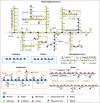Daily glycome and transcriptome profiling reveals polysaccharide structures and correlated glycosyltransferases critical for cotton fiber growth
- PMID: 39441672
- PMCID: PMC11629744
- DOI: 10.1111/tpj.17084
Daily glycome and transcriptome profiling reveals polysaccharide structures and correlated glycosyltransferases critical for cotton fiber growth
Abstract
Cotton fiber is the most valuable naturally available material for the textile industry and the fiber length and strength are key determinants of its quality. Dynamic changes in the pectin, xyloglucan, xylan, and cellulose polysaccharide epitope content during fiber growth contribute to complex remodeling of fiber cell wall (CW) and quality. Detailed knowledge about polysaccharide compositional and structural alteration in the fiber during fiber elongation and strengthening is important to understand the molecular dynamics of fiber development and improve its quality. Here, large-scale glycome profiling coupled with fiber phenotype and transcriptome profiling was conducted on fiber collected daily covering the most critical window of fiber development. The profiling studies with high temporal resolution allowed us to identify specific polysaccharide epitopes associated with distinct fiber phenotypes that might contribute to fiber quality. This study revealed the critical role of highly branched RG-I pectin epitopes such as β-1,4-linked-galactans, β-1,6-linked-galactans, and arabinogalactans, in addition to earlier reported homogalacturonans and xyloglucans in the formation of cotton fiber middle lamella and contributing to fiber plasticity and elongation. We also propose the essential role of heteroxylans (Xyl-MeGlcA and Xyl-3Ar), as a guiding factor for secondary CW cellulose microfibril arrangement, thus contributing to fiber strength. Correlation analysis of profiles of polysaccharide epitopes from glycome data and expression profiles of glycosyltransferase-encoding genes from transcriptome data identified several key putative glycosyltransferases that are potentially involved in synthesizing the critical polysaccharide epitopes. The findings of this study provide a foundation to identify molecular factors that dictate important fiber traits.
Keywords: Gossypium hirsutum; cellulose; cotton fiber; glycome profiling; glycosyltransferases; pectin; polysaccharide epitopes; transcriptome profiling; xylan; xyloglucan.
© 2024 The Author(s). The Plant Journal published by Society for Experimental Biology and John Wiley & Sons Ltd.
Conflict of interest statement
The authors declare no conflict of interest.
Figures











Similar articles
-
Two cotton fiber-associated glycosyltransferases, GhGT43A1 and GhGT43C1, function in hemicellulose glucuronoxylan biosynthesis during plant development.Physiol Plant. 2014 Oct;152(2):367-79. doi: 10.1111/ppl.12190. Epub 2014 Apr 12. Physiol Plant. 2014. PMID: 24641584
-
Cotton fiber cell walls of Gossypium hirsutum and Gossypium barbadense have differences related to loosely-bound xyloglucan.PLoS One. 2013;8(2):e56315. doi: 10.1371/journal.pone.0056315. Epub 2013 Feb 14. PLoS One. 2013. PMID: 23457548 Free PMC article.
-
A Fresh Look at Celery Collenchyma and Parenchyma Cell Walls Through a Combination of Biochemical, Histochemical, and Transcriptomic Analyses.Int J Mol Sci. 2025 Jan 16;26(2):738. doi: 10.3390/ijms26020738. Int J Mol Sci. 2025. PMID: 39859452 Free PMC article.
-
Heteromannan and Heteroxylan Cell Wall Polysaccharides Display Different Dynamics During the Elongation and Secondary Cell Wall Deposition Phases of Cotton Fiber Cell Development.Plant Cell Physiol. 2015 Sep;56(9):1786-97. doi: 10.1093/pcp/pcv101. Epub 2015 Jul 16. Plant Cell Physiol. 2015. PMID: 26187898 Free PMC article.
-
GhMYB102 affects cotton fibre elongation and secondary wall thickening by regulating GhIRX10 in cotton.Plant Biotechnol J. 2025 Apr;23(4):1329-1344. doi: 10.1111/pbi.14588. Epub 2025 Feb 18. Plant Biotechnol J. 2025. PMID: 39966942 Free PMC article.
Cited by
-
A high-resolution model of gene expression during Gossypium hirsutum (cotton) fiber development.BMC Genomics. 2025 Mar 6;26(1):221. doi: 10.1186/s12864-025-11360-z. BMC Genomics. 2025. PMID: 40050725 Free PMC article.
-
A cell fractionation and quantitative proteomics pipeline to enable functional analyses of cotton fiber development.Plant J. 2025 Feb;121(4):e17246. doi: 10.1111/tpj.17246. Plant J. 2025. PMID: 39970036 Free PMC article.
References
-
- Abidi, N. , Cabrales, L. & Haigler, C.H. (2014) Changes in the cell wall and cellulose content of developing cotton fibers investigated by FTIR spectroscopy. Carbohydrate Polymers, 100, 9–16. - PubMed
-
- An, C. , Saha, S. , Jenkins, J.N. , Scheffler, B.E. , Wilkins, T.A. & Stelly, D.M. (2007) Transcriptome profiling, sequence characterization, and SNP‐based chromosomal assignment of the EXPANSIN genes in cotton. Molecular Genetics and Genomics, 278, 539–553. - PubMed
-
- Applequist, W.L. , Cronn, R. & Wendel, J.F. (2001) Comparative development of fiber in wild and cultivated cotton. Evolution and Development, 3, 3–17. - PubMed
-
- Atalla, R.H. , Hackney, J.M. , Uhlin, I. & Thompson, N.S. (1993) Hemicelluloses as structure regulators in the aggregation of native cellulose. International Journal of Biological Macromolecules, 15, 109–112. - PubMed
MeSH terms
Substances
Grants and funding
LinkOut - more resources
Full Text Sources

